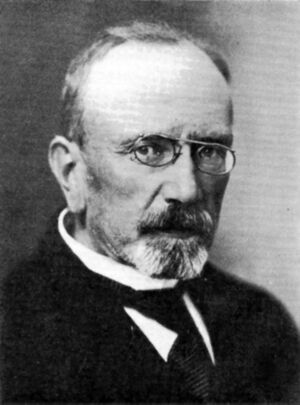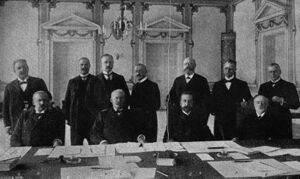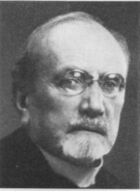يالمار همرشولد
| يالمار همرشولد Hjalmar Hammarskjöld | |
|---|---|

| |
| Hjalmar Hammarskjöld | |
| رئيس وزراء السويد | |
| في المنصب 17 February 1914 – 30 March 1917[1] | |
| العاهل | Gustaf V |
| سبقه | Karl Staaff |
| خلفه | Carl Swartz |
| Minister of Education and Ecclesiastical Affairs | |
| في المنصب 2 August – 7 November 1905 | |
| رئيس الوزراء | Christian Lundeberg |
| سبقه | Karl Husberg |
| خلفه | Fridtjuv Berg |
| Minister of Justice | |
| في المنصب 5 December 1901 – 2 August 1902 | |
| رئيس الوزراء | Fredrik von Otter |
| سبقه | Ludvig Annerstedt |
| خلفه | Ossian Berger |
| تفاصيل شخصية | |
| وُلِد | Knut Hjalmar Leonard Hammarskjöld 4 فبراير 1862 Tuna, United Kingdoms of Sweden and Norway |
| توفي | 12 أكتوبر 1953 (aged 91) ستوكهولم، السويد |
| الحزب | Independent[2] |
| الزوج | |
| الأنجال | 4، منهم Åke و داگ |
| التوقيع | |
كنوت يالمار ليونارد همرشولد ( Knut Hjalmar Leonard Hammarskjöld ؛ السويدية: [ˈjǎlmar ˈhâmːarˌɧœld]؛ 4 فبراير 1862 – 12 أكتوبر 1953) كان سياسياً سويدياً ودارساً، شغل منصب رئيس وزراء السويدي من 1914 حتى 1917. He was a member of the Riksdag from 1923 to 1938 in the first chamber.[3] He headed Sweden's government during most of World War I, and maintained the nation's neutrality in that conflict. He was ideologically conservative, although he was never officially a member of any political party.[2]
A member of the prominent Hammarskjöld family, he studied law at Uppsala University. He later served as Minister for Justice and Minister of Education and Ecclesiastical Affairs.[4] He was appointed as prime minister following the resignation of Karl Staaff.
During World War I, although he was perceived as pro-German, he perused a policy of neutrality. He rejected a trade agreement with Britain, and food shortages led to protests against his government. Hammarskjöld resigned in 1917. He continued to hold political offices and continued his scholarly work. He died in 1953. He was the father of Dag Hammarskjöld, the second United Nations Secretary General from 1953 to 1961.
الحياة والعمل
النشأة
The son of lieutenant Knut Vilhelm Hammarskjöld and Maria Lovisa Cecilia Vilhelmina Cöster, Knut Hjalmar Leonard Hammarskjöld was born into the Hammarskjöld family on 4 February 1862,[5][6] at Väderum's farm in Tjust in Tuna, Vimmerby, Kalmar County.[7][8] Knut Hammarskjöld was a noble, landowner and female line descendant of an illegitimate daughter of Eric XIV of Sweden.[بحاجة لمصدر] Hjalmar's younger brother Carl Gustaf Hammarskjöld later became Sweden's minister of defence.[9]
Hammarskjöld was a versatile legal expert and prominent as both a scholar and as a legislator. In 1891 he became a professor in Uppsala University and had a great influence on Swedish and Nordic civil law. He laid the foundation for his reputation as an expert in international law at the same time through diligent work in international meetings, and became a member of the Permanent Court of Arbitration in 1904 at The Hague. He was a participant at the Second Hague Peace Conference in 1907.[10]
On 3 September 1890, he married Agnes Maria Carolina Almquist (15 January 1866–21 January 1940). The couple had four sons: Bo, Åke, Sten and Dag.[11][12] Agnes was the daughter of director general Gustaf Fridolf Almquist and his wife Maria Vilhelmina Gradin.[5]
السيرة السياسية المبكرة

From 5 December 1901 to 2 August 1902 Hammarskjöld served as Minister of Justice in Fredrik von Otter's government.[5] In this position, he made an ambitious but unsuccessful attempt to resolve the problems concerning the right to vote, and was, on his resignation, appointed president of the Göta Court of Appeal.[بحاجة لمصدر]
In 1905, he returned to politics as part of as a member of Christian Lundeberg's coalition government,[4] being the only member of the cabinet who had previously served in another cabinet.[13] In this cabinet he became Minister of Education and Ecclesiastical Affairs. In this position, he was one of the negotiators of the dissolution of the union between Sweden and Norway in Karlstad.[4] His term began on 2 August of that year.[5] Lundberg, who lead conservatives in the Riksdag, chose Hammarskjöld to discuss the legal aspects of the agreement with the Norwegians. Hammarskjöld resisted making concessions to the Norwegians, and they regarded him as the person most responsible for their failure to attain more favorable conditions for the dissolution.[14] The working relationship between the Swedish delegates was good, and Hammarskjöld was specifically pleased with his cooperation with the Liberal politician Karl Staaff.[5] His term ended on 7 November of that year.[5]
In 1905, after Lundenerg's government ended, Staaff became prime minister, and he appointed Hammarskjöld to be the Swedish ambassador to Copenhagen in December of that year. This was considered to be an important position at the time, as following the dissolution of the Swedish-Norwegian union, Scandinavian tensions were increasing.[5][15] After two years, relations had eased again.[15] However, Hammarskjöld found the independence of the role unappealing. He returned in October 1907 to Uppsala to serve as its county governor,[5] but often took leave of absence for various other assignments.
After the Second Moroccan Crisis, tensions reignited between Sweden and Denmark. Hammarskjöld was sent back to Copenhagen to negotiate in 1912, specifically disagreements over territorial waters, pilot and navigational rules, and the expectations of neutral countries during wartime. The negotiations quickly ended the disputes.[16]
رئيس الوزراء
After the peasant armament support march (Swedish: bondetåget) and the resignation of the liberal government, he became head of a non-parliamentarian government in 1914, tasked with solving defense issues.[17] His "courtyard government" (Swedish: borggårdsregering) was politically independent, but loyal to the king and rather conservative. It was created on an initiative from Arvid Lindman, the leader of the right-wing party in the second chamber, who did not want the king to appoint a cabinet under the leader of the right-wing party in the first chamber, Ernst Trygger.
After the outbreak of the First World War that same year, a truce was established between the parties and the defense problem was solved to the satisfaction of the military. Hammarskjöld was principled and inflexible in his interpretations of civil law during the height of the war. It was during this time that the term 'Hunger shield' (Swedish: Hungerskjöld) was coined, because his intractability impeded efforts to get necessary food exports into Sweden. He was seen as too friendly towards Germany when he rejected the proposal for a common trade agreement with Great Britain that Marcus Wallenberg, brother of the foreign minister Knut Wallenberg, had brought home from London in 1917. The split between the PM and the Foreign Minister became apparent and the leaders of the right-wing in the parliament revoked their support for the prime minister, who was forced to submit his resignation.
Hammarskjöld had a dominant nature and was perceived by his opponents as authoritarian and strong-willed, but claims that he favoured Germany lack documented support.
الحياة اللاحقة

He had many prestigious assignments, for example chairman of the Nobel Foundation 1929–1947.
He served in the first chamber of the Riksdag from 1923 through 1938. He was supported by the conservative National Election League, but never joined it or any other party. He often commented on political disputes in sharp and sarcastic ways, but gained the general respect of his peers.[5]
He was voted into the Swedish Academy in 1918[4][18] to the same chair as Prime Minister Louis De Geer had occupied,[بحاجة لمصدر] number 17. Hammarskjöld's son, Dag, inherited the chair, as well as the position, after his death.[7] Hammarskjöld's investigations were a major contributing factor to the decision to establish the Supreme Administrative Court of Sweden.
Hjalmar Hammarskjöld died on 12 October 1953 in Stockholm,[19] just over six months after his youngest son became the second Secretary General of the United Nations.
أدبيات
- T. Gihl, The history of Swedish foreign policy 4 (1951)
- D. Hammarskjöld, Hjalmar Hammarskjöld: entry speech in the Swedish Academy (1954)
- W. Carlgren, The minister Hammarskjöld (1967)
- S.A. Söderpalm, The big company owners and the democratic breakthrough (1969)
المراجع
- ^ Rustow 1955, p. 244
- ^ أ ب Rustow 1955, p. 82
- ^ "Sweden" (in السويدية). World Statesmen. Retrieved 22 December 2014.
- ^ أ ب ت ث Thelander, Joakim (2006-01-28). "Hjalmar Hammarskjöld (1862-1953)" (in السويدية). Populär Historia. Retrieved 2023-12-13.
- ^ أ ب ت ث ج ح خ د ذ Herlitz, Nils. "K Hjalmar L Hammarskjöld". Riksarkivet (in السويدية). Svenskt biografiskt lexikon. Retrieved 2024-03-11.
- ^ Hammarskjöld 1915, p. 431
- ^ أ ب Olsson, Sophie (2021-09-18). "En Dag till minne av Hammarskjöld" (in السويدية). Vimmerby Tidning. Retrieved 2024-03-10.
- ^ Afzelius 1953, p. 673
- ^ Kungl. Skogs- och lantbruksakademien (1937). Handlingar och tidskrift, vol. 76 (in السويدية). Stockholm: Akademien. p. 624.
- ^ Jonas, Michael (2021) (in en), Hammarskjöld at The Hague: Sweden and the Peace Conference of 1907, Oxford University Press, pp. 113–141, doi:, ISBN 978-0-19-886383-0, https://oxford.universitypressscholarship.com/view/10.1093/oso/9780198863830.001.0001/oso-9780198863830-chapter-6
- ^ Hammarskjöld 1915, p. 433
- ^ Heller 2001, p. 11
- ^ Lindgren 1959, p. 150
- ^ Lindgren 1959, p. 173
- ^ أ ب Afzelius 1953, p. 676
- ^ Lindgren 1959, pp. 236-237
- ^ Ahlund 2015, pp. 16-17
- ^ Scobbie 2010, p. 88
- ^ Heller 2001, p. 165
ببليوجرافيا
- Afzelius, Axel (1953). "Hjalmar Hammarskjöld". Svensk Juristtidning (in السويدية).
- Ahlund, Claes, ed. (2015). Scandinavia in the First World War: Studies in the War Experience of Northern Neutrals. Lund: Nordic Academic Press. ISBN 978-91-87121-90-6.
- Hammarskjöld, Nina (1915). Ätten Hammarskjöld: personhistoria och tidsbilder från tre hundra år, berättade för släkten (in السويدية). Stockholm: Cederquists Grafiska Aktiebolag.
- Heller, Peter B. (2001). The United Nations under Dag Hammarskjöld, 1953-1961. The Scarecrow Press, Inc. ISBN 0-8108-3699-8.
- Lindgren, Raymond E. (1959). Norway-Sweden: Union, Disunion, and Scandinavian Integration. Princeton University Press. ISBN 978-1-4008-7825-3.
- Rustow, Dankwart A. (1955). The Politics of Compromise. Princeton University Press. ISBN 9781400878581.
- Scobbie, Irene (2010). The A to Z of Sweden. Scarecrow Press. ISBN 978-0-8108-7218-9.
للاستزادة
- Ahlund, Claes (2012). Scandinavia in the First World War: Studies in the War Experience of the Northern Neutrals. Nordic Academic Press. ISBN 9789187121579.
- Elgán, Elisabeth; Scobbie, Irene (2015). Historical Dictionary of Sweden. Rowman & Littlefield Publishers. ISBN 9781442250710.
- Svegfors, Mats (2012). Sveriges statsministrar under 100 år. Hjalmar Hammarskjöld (in السويدية). Albert Bonniers Förlag. ISBN 9789100132446.
وصلات خارجية
| مناصب سياسية | ||
|---|---|---|
| سبقه Karl Staaff |
Prime Minister of Sweden 1914-1917 |
تبعه Carl Swartz |
| مناصب منظمات غير ربحية | ||
| سبقه Henrik Schück |
رئيس مؤسسة نوبل 1929–1947 |
تبعه Birger Ekeberg |
| مناصب ثقافية | ||
| سبقه Pehr Jacob von Ehrenheim |
الأكاديمية السويدية, Seat No.17 1918-1953 |
تبعه داگ همرشولد |
- CS1 السويدية-language sources (sv)
- Short description is different from Wikidata
- Pages with plain IPA
- مقالات ينقصها مصادر موثوقة
- مقالات ينقصها مصادر موثوقة from March 2024
- Articles with unsourced statements from March 2024
- Articles with hatnote templates targeting a nonexistent page
- Articles containing سويدية-language text
- مواليد 1862
- وفيات 1953
- People from Vimmerby Municipality
- Members of the Första kammaren
- أعضاء الأكاديمية السويدية
- Swedish nobility
- Swedish Lutherans
- رؤساء وزراء السويد
- خريجو جامعة أوپسالا
- Members of the Permanent Court of Arbitration
- Governors of Uppsala County
- Burials at Uppsala old cemetery
- 20th-century Swedish judges
- Swedish judges of international courts and tribunals
- Swedish people of Belgian descent
- Members of the Royal Society of Sciences in Uppsala
- Hammarskjöld family
- Swedish Ministers of Education and Ecclesiastical Affairs
